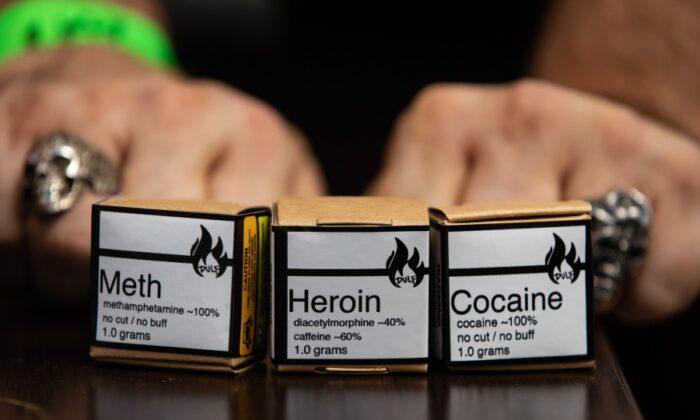
They had one job to get right and they opted for a free for all rather than what has been applied everywhere else it has been successful.
If you are addicted, you are one sick puppy as in sick. that means carefully prescribed drugs and working recovery protocols aimed at restoring client usefulness.
Instead we get the worse case scenario and we allow addicts to kill themselves without a bye you bye.
.
Talk about the stupidity of governments. And no one fixes this?
Canada’s Failed ‘Safer Supply’ Drug Experiment a Cautionary Tale for the World
Talk about the stupidity of governments. And no one fixes this?
Canada’s Failed ‘Safer Supply’ Drug Experiment a Cautionary Tale for the World
Methamphetamine, heroin, and cocaine from a safe supply are handed out to drug users to mark International Overdose Awareness Day, in the Downtown Eastside of Vancouver on Aug. 31, 2021. (Darryl Dyck/The Canadian Press)
By Adam Zivo
1/8/2024
Commentary
Faced with an overdose crisis that is killing thousands of people every year, Canada decided to embrace “safer supply,” a strategy that distributes free addictive drugs as an alternative to potentially tainted illicit substances. Yet the results have been disastrous and should serve as a cautionary tale for other jurisdictions.
The rationale behind safer supply is not actually unreasonable. Overdoses, infections and deaths often occur because addicts consume street drugs that have unpredictable doses and contaminants—so why not provide safer substances that are less likely to kill users until they are ready to seek treatment?
A responsible model of safer supply would provide these drugs on a temporary basis, under strict supervision and with clear recovery-oriented goals. High barriers to entry would be vital to ensure that safer supply is only given to people who have been repeatedly failed by other options, so as to not dissuade clients from seeking traditional addiction treatment.
Yet Canada’s model of safer supply takes the opposite approach and is profoundly reckless.
Clients receive free drugs indefinitely and are generally not shepherded toward recovery. As there is a strong focus on “lowering barriers,” accessing safer supply is often, but not always, fairly easy. This has led addiction physicians to complain that patients are abandoning treatment in favour of using taxpayer-funded drugs.
Canada’s model of safer supply simply enables addiction and amounts to little more than palliative care. It gives up on addicts and only keeps them comfortable until they die by their own destructive habits, and then frames this as “compassion.”
Worse yet, the drugs being distributed are not fit to purpose, which is causing significant harm to both drug users and surrounding communities.
Canadian safer supply programs typically distribute 8mg tablets of hydromorphone, an opioid as potent as heroin. A single tablet is four times the dose typically used to manage post-surgery pain in a hospital setting, and just two or three are enough to induce an overdose in an opioid-naive user, especially if mixed with alcohol.
Yet most opioid addicts abuse fentanyl, which is 30–50 times stronger than heroin and hydromorphone. To overcome this difference, safer supply programs give huge amounts of tablets to clients—generally between 10–30 per day, although there have been reports of clients receiving as many as 40 or 50 tablets daily.
Yet dozens of respected addiction physicians have told me over the past year that even these large doses of hydromorphone do not satisfy fentanyl addicts, as such users have a formidable opioid tolerance. The federal government is aware of this issue and acknowledged in a 2022 report that maximal doses of hydromorphone produce little effect for fentanyl addicts beyond reducing withdrawal symptoms.
To enhance the effects of these tablets, addicts typically crush and inject them, but the tablets are designed for oral use and contain materials that are unsafe for injection. As a result, this practice, which is condoned by the government, can lead to excruciating infections that can leave some patients paralyzed.
As fentanyl users do not enjoy hydromorphone tablets, they regularly sell (“divert”) their safer supply on the street to purchase their substance of choice—which means that safer supply is actually subsidizing, not mitigating, the illicit fentanyl market.
These tablets then flood into surrounding communities, crashing the street price of hydromorphone.
While 8mg tablets of hydromorphone used to sell for $20 apiece, they now can be purchased for as little as $1. According to numerous addiction experts and former drug addicts I interviewed last year, the tablets are cheapest outside pharmacies that dispense safer supply. However, drug dealers often purchase them in bulk, often by working with teams of safer supply clients, and then resell them across the country at a wholesale price of $3–$5 per tablet.
As the tablets are not attractive to people with a high opioid tolerance, they disproportionately end up being purchased by people who are in recovery, which then spurs relapses, or, more troublingly, by youth.
I have interviewed dozens of youth who have told me that “dillies” (the street slang for hydromorphone) suddenly became popular two years ago which, coincidentally, is when safer supply expanded. Many of these youths explicitly said that they and their friends had purchased dillies originating from safer supply.
Many of these youth tried dillies because they did not understand that hydromorphone is equivalent to heroin. All they knew was that it was for “pain relief” and that it was “safe” and pharmacy-prescribed–and then they became hopelessly addicted. Some even graduated to fentanyl.
As far as policy disasters go, safer supply is stupendous. The program does not reduce harm, but only multiplies it. Yet Canadian policymakers continue to embrace the strategy despite mounting resistance and calls for reform.
Let this be a warning to other countries. When ideology trumps evidence, people die.
No comments:
Post a Comment